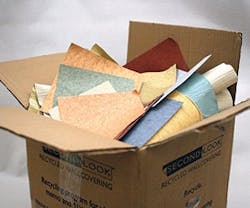Is that wallcovering in your lobby, classrooms or hotel suites ready to get an update? Before you start ripping down tired designs, set up a recycling stream to capture this waste. It takes no more coordination than dedicating a bin and instructing your crew to divert the material. Even better, manufacturers are eager to take back this commodity at no cost to you.
Waste or Resource
There’s more to recycling than collecting cardboard and aluminum cans on a weekly basis. Whether embarking on a minor refresh or a complete renovation, facility managers should keep their eyes open for one-time opportunities to salvage items. Think of wallcoverings as a cousin to carpet – even though the product will likely ugly out before it wears out, there’s no reason to send this bulky material to the landfill when others can take it off your hands.
“Beyond being good municipal citizens, building owners should recycle wallcoverings to avoid construction waste and the associated costs from dumpster rentals, hauling and contractor services,” explains Beth Rich, Marketing Director for Versa Wallcovering.
Wallcoverings made from vinyl and fabrics, particularly textiles with polyesters, are good candidates for recycling.
"Most commercial vinyls can be saved because they come down in one piece and are easy to separate from the sheet rock,” notes Sean Samet, Executive Director of the Wallcoverings Association. “It may seem like a small amount, but any scraps left over from an installation job can also be diverted.”
Work with your general contractor, installer or the manufacturer to coordinate recycling. The Second-Look program offered by Versa Wallcoverings accepts any previously used vinyl wallcoverings, says Rich. Once a sample has been tested to rule out any chemicals or elements such as heavy metals that are considered contaminants, FMs are provided with a container to separate materials. The free program has recycled 6.5 million pounds of wallcoverings since 2007.
It’s also a closed loop option, ensuring that reclaimed materials are turned into new wallcoverings: “Everyone wants products with recycled content, but manufacturers need to get the material back in order to increase that percentage in the first place,” Rich stresses.
Recycling vinyl is also eco-friendly because it doesn’t degrade when it’s reformed into new products, making its performance and durability on par with virgin materials, Samet adds.
Plan Ahead for Success
One of the key drivers of sustainability is to change our mindset about our definition of waste and think instead about resource recovery. It’s routine to just throw away products we no longer have a use for rather than finding a partner who sees the potential, says Samet. But with wallcoverings, as with many other materials that are recyclable, the effort to minimize your landfill contributions is no more of a hassle than having a space for a dedicated dumpster and keeping materials dry.
“There’s a perception that it’s difficult and costly to recycle wallcoverings when the opposite is true. The problem is that it’s usually an afterthought rather than something that’s part of the project scope,” Rich clarifies. “You need to coordinate this from the onset with the construction or renovation company.”
Wallcoverings can generally be removed without any problems if they were installed properly.
“It’s important to follow the specifications for wallcoverings because they’re meant to be taken down in one piece without damaging the wall,” notes Samet. “You might run into trouble if the wrong adhesive or covering was used, the wallcovering was installed too quickly without priming or preparing the surface, or it was put over another surface already in place.”
Barring these complications, recycling old wallcoverings should be a simple process. Be sure to ask for the final weight of collected materials. You can apply the data to several building certifications or simply make your occupants aware that you’re following through with your green goals.
Jennie Morton [email protected] is Senior Editor of BUILDINGS.
About the Author
Jennie Morton
A former BUILDINGS editor, Jennie Morton is a freelance writer specializing in commercial architecture, IoT and proptech.
